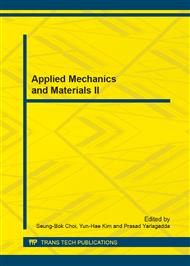p.1278
p.1284
p.1288
p.1293
p.1298
p.1303
p.1307
p.1316
p.1321
The Effect of Initial Microstructure on the Dynamic Mechanical Behavior of Titanium Plate at Different Strain Rates
Abstract:
The dynamic mechanical property and microstructure evolution of commercial pure titanium with initial lamellar dislocation boundary structures were studied at different strain rate compression. The experiments were conducted to the cylindrical specimens using Gleeble-3500 thermal mechanical simulation machine at room temperature. With increasing of the strain rate, strain rate strengthening effect was found in the material. New dislocation boundary structures along impact direction were generated which perpendicular to initial dislocation boundary. Then the S bands boundary structure was formed by interaction between new and initial dislocations. It can be supposed that initial dislocation boundary are sheared and kinked by new dislocation slipping.
Info:
Periodical:
Pages:
1298-1302
Citation:
Online since:
December 2013
Authors:
Price:
Сopyright:
© 2014 Trans Tech Publications Ltd. All Rights Reserved
Share:
Citation:


